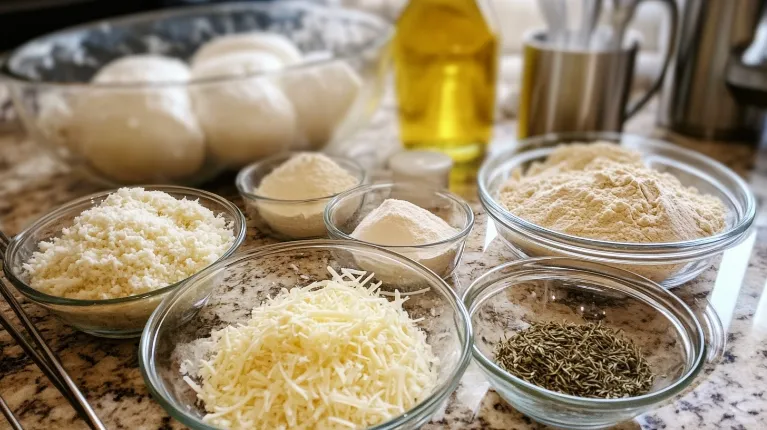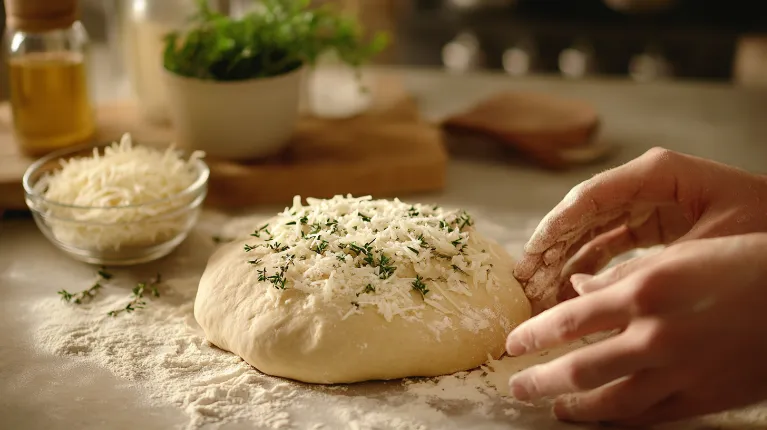Introduction
There’s just something magical about the aroma of fresh-baked bread wafting through the house—don’t you think? And when that bread happens to be Italian herbs and cheese bread, it’s like your kitchen transforms into a cozy corner of an Italian bakery. This bread, with its golden crust and perfectly seasoned interior, isn’t just a carb—it’s an experience. Moreover, it’s versatile enough to complement soups, salads, or even serve as the base for a killer sandwich.
What makes this bread so special, you ask? It’s all about the blend of fragrant herbs and gooey cheese that packs each bite with flavor. Honestly, if you’ve never tried making it at home, you’re in for a treat! Oh, and by the way, if you’re curious about the perfect balance of herbs, check out this comprehensive list of culinary herbs. You might discover your new favorite ingredient.
Let’s dive right in, starting with a bit of history and why this bread deserves a spot in your baking repertoire.
History and Origin
Every recipe has a story, and Italian herbs and cheese bread is no exception. Picture this: centuries ago, Italian bakers began experimenting with aromatic herbs like rosemary, oregano, and thyme. These weren’t just for flavor—they were a nod to the rich agricultural heritage of the Mediterranean. Herbs were plentiful, easy to grow, and added a layer of complexity to even the simplest dishes.
Now, throw cheese into the mix. In regions like Tuscany and Emilia-Romagna, cheese wasn’t just a luxury; it was a way of life. Parmesan, pecorino, and even mozzarella found their way into bread dough, creating a hearty snack that could sustain farmers through long workdays. The pairing of herbs and cheese wasn’t just practical—it was genius.
Fast forward to today, and this bread has become a global favorite, thanks in part to chains like Subway popularizing their version. But let’s be real—the homemade version? It’s on another level entirely.
So, while you could buy a loaf at the store, there’s something so satisfying about kneading the dough yourself. Plus, you get to customize it with your favorite herbs and cheese. Whether it’s a classic oregano-Parmesan combo or a spicy basil-jack blend, the possibilities are endless.
Ingredients and Equipment
Ingredients Table
| Ingredient | Quantity | Suggested Substitutions |
|---|---|---|
| All-purpose flour | 3 ½ cups | Bread flour for extra chewiness |
| Sugar | 2 tbsp | Honey or agave syrup |
| Salt | 1 ½ tsp | Kosher salt |
| Yeast | 2 ¼ tsp | Instant yeast for faster rising |
| Warm water | 1 ¼ cups | Milk for a richer dough |
| Olive oil | 2 tbsp | Melted butter |
| Dried oregano | 1 tsp | Basil or thyme |
| Dried rosemary | 1 tsp | Fresh rosemary (2 tsp, chopped) |
| Grated Parmesan | 1 cup | Asiago or Pecorino |
| Mozzarella (shredded) | 1 cup | Cheddar or Monterey Jack |

Equipment List
- Large mixing bowl
- Measuring cups and spoons
- Whisk
- Dough scraper
- Baking sheet or loaf pan
- Parchment paper
- Clean kitchen towel
Step-by-Step Guide to Making Italian Herbs and Cheese Bread at Home
Making Italian herbs and cheese bread from scratch might sound intimidating, but it’s easier than you think. Plus, there’s nothing quite like the satisfaction of pulling a golden, cheesy loaf out of your oven. Here’s a simple step-by-step guide to help you whip up this delicious bread. Follow along, and by the end, your kitchen will smell like heaven!
Preparing the Dough
Step 1: Gather Your Ingredients First, gather all the ingredients listed above. Ensure your water is warm, not hot—it should feel like a soothing bath for your fingers. Hot water can kill the yeast, so aim for about 110°F.
Step 2: Activate the Yeast In a large mixing bowl, combine the warm water, sugar, and yeast. Give it a gentle stir and let it sit for 5–10 minutes. You’ll know the yeast is alive and kicking when you see a frothy layer on top—kind of like the foam on a cappuccino.
Pro Tip: If your yeast doesn’t foam, don’t panic. It might be old or your water was too hot. Try again with fresh yeast and properly warmed water.
Step 3: Mix the Dough Next, add olive oil, salt, and about 2 cups of flour to the yeast mixture. Stir until it forms a sticky batter. Then, gradually add the remaining flour, about ½ cup at a time, until the dough starts to pull away from the sides of the bowl.
Step 4: Knead the Dough Transfer the dough to a floured surface. Knead it for about 8–10 minutes, pushing it away from you with the heels of your hands and folding it back. Repeat until the dough is smooth and elastic. (It’s like a mini arm workout—bonus!)
Incorporating Herbs and Cheese
Step 5: Season the Dough Sprinkle the dried oregano and rosemary over the dough, then knead for another 1–2 minutes to evenly distribute the herbs. For an extra punch of flavor, you can mix in some garlic powder or chili flakes.
Step 6: Add the Cheese Flatten the dough slightly, sprinkle half the Parmesan and mozzarella over it, and fold it like a letter. Repeat this process with the remaining cheese to ensure it’s evenly incorporated.
Shaping and Proofing the Loaf
Step 7: Shape the Dough Once the cheese and herbs are mixed in, shape the dough into a loaf or rolls, depending on your preference. Place the dough on a parchment-lined baking sheet or in a lightly greased loaf pan.
Step 8: Let It Rise Cover the dough with a clean kitchen towel and place it in a warm, draft-free spot. Let it rise for about an hour, or until it has doubled in size.
Pro Tip: If your kitchen is cold, preheat your oven to 200°F for 2 minutes, then turn it off. Place the dough inside to rise—just make sure the oven isn’t too hot!
Baking Process
Step 9: Preheat the Oven Preheat your oven to 375°F (190°C). While it’s heating up, brush the top of the dough with a little olive oil and sprinkle on a mix of Parmesan and your favorite dried herbs.
Step 10: Bake the Bread Pop the bread into the preheated oven. Bake for 25–30 minutes for a loaf, or about 20 minutes for rolls. The bread is ready when it’s golden brown on top and sounds hollow when you tap it.
Step 11: Cool and Rest Once baked, remove the bread from the oven and let it cool on a wire rack for at least 15 minutes. This step is crucial—it allows the cheese to set and prevents a gummy texture.

Tips for Perfect Bread Every Time
- Don’t Skip the Resting Time: Letting the dough rise properly ensures a soft, airy texture.
- Customize the Herbs and Cheese: Experiment with combinations like basil and Asiago or thyme and Gruyere.
- Store It Right: Wrap leftovers in foil or plastic wrap to keep them fresh for up to 3 days.
Congratulations! You’ve just baked your very own loaf of Italian herbs and cheese bread. Whether you enjoy it fresh from the oven or save some for later, this bread is bound to become a family favorite. Next up, let’s explore the nutritional profile and health benefits of this irresistible recipe.
Tips and Troubleshooting for Perfect Italian Herbs and Cheese Bread
Making Italian herbs and cheese bread at home can be a breeze if you know a few tricks. However, like any recipe, there are common challenges that bakers may face. Here’s how to perfect your loaf every time.
Tips for Perfecting the Recipe
Measure Ingredients Carefully
First and foremost, baking is a science, so precise measurements matter. Use measuring cups for dry ingredients and a kitchen scale for better accuracy.
Don’t Overwork the Dough
While kneading is essential for developing gluten, over-kneading can make your bread tough. Aim for a smooth, slightly elastic dough that’s not sticky. However, if you find it sticking to your hands too much, lightly flour your surface instead of adding extra flour to the dough.
Use Fresh Herbs When Possible
While dried herbs work well, fresh ones can take your bread to the next level. Chop them finely for better incorporation. On the other hand, if using dried herbs, make sure they’re not too old, as stale herbs lack flavor.
Achieving the Perfect Rise
If your dough isn’t rising, it could be due to the yeast. Ensure the yeast is active and your water temperature is just right—not too hot, not too cold. A warm spot, like a sunny window or a gently warmed oven, can make all the difference.
Troubleshooting Common Problems
Dough Too Sticky?
Add a tablespoon of flour at a time while kneading. However, be cautious—too much flour can make the bread dense.
Loaf Didn’t Rise Enough?
This could be due to under-proofing or expired yeast. Give the dough more time in a warm place, but don’t overdo it, as over-proofing can collapse the loaf.
Cheese Not Melting Evenly?
Try grating the cheese finely or layering it differently. You can even save some for sprinkling on top for a golden crust.
Serving and Garnishing Ideas
Once you’ve baked your Italian herbs and cheese bread, it’s time to make it shine on the table. The right presentation and pairing can elevate it from delicious to unforgettable.
Creative Serving Suggestions
As a Side Dish
Pair your bread with hearty soups, like tomato bisque or creamy potato soup. It’s also a perfect match for fresh salads, especially Caesar or Mediterranean varieties.
Make It a Sandwich Star
Slice your bread and use it to make gourmet sandwiches. Think grilled chicken with pesto or a vegetarian combo of roasted veggies and hummus.
Toast It Up
Cut slices, toast them lightly, and spread with garlic butter for an irresistible snack. For something sweeter, try a drizzle of honey or a slather of berry jam.
Garnishing and Presentation
For a beautiful presentation, brush the top with olive oil and sprinkle some fresh herbs or coarse sea salt before serving. Add a small dipping bowl of olive oil infused with garlic and chili flakes for a rustic Italian touch.
Pair your Italian herbs and cheese bread with hearty main dishes for a complete meal. If you’re looking for a savory companion, try this delicious Cajun Shrimp Pasta. The spicy shrimp balances beautifully with the cheesy, herb-infused bread.
Your Italian herbs and cheese bread is now ready to be served, admired, and devoured. Whether you enjoy it as a quick snack or the centerpiece of a meal, this bread truly steals the show. For more delicious recipes, don’t forget to explore the other bread recipes on our site!
Healthier Alternatives and Dietary Considerations
When it comes to Italian herbs and cheese bread, there are plenty of ways to make it suit your dietary preferences or health goals. Whether you’re cutting back on calories or need a gluten-free option, you can enjoy this delicious bread with a few smart tweaks.
Healthier Ingredient Swaps
Go Whole Grain
Instead of all-purpose flour, use whole wheat flour or a mix of whole wheat and bread flour. This increases the fiber content while maintaining a soft texture.
Low-Fat Cheese Options
Swap out full-fat mozzarella and Parmesan for reduced-fat versions. Additionally, you can use nutritional yeast as a topping for a cheesy flavor without the added fat.
Reduce Sodium
If you’re watching your sodium intake, opt for unsalted butter and low-sodium cheese. Also, consider reducing the amount of added salt in the dough by half.
Gluten-Free Version
For gluten-free bakers, substitute all-purpose flour with a 1:1 gluten-free baking blend. However, keep in mind that the dough may require additional liquid for the right consistency.
Dietary Considerations
Vegan Adaptation
Replace the cheese with vegan cheese alternatives, and use olive oil or a plant-based butter substitute. Additionally, ensure your sugar is vegan-friendly, as some brands use bone char in processing.
Lactose-Free Option
Lactose-intolerant? No worries! Opt for aged cheeses like Parmesan or lactose-free mozzarella to keep things creamy and flavorful.
If you’re exploring more nutritious bread options, why not try our Avocado Cottage Cheese Bread Recipe? It’s packed with healthy fats and makes a great addition to any balanced diet.
Storing and Reheating
Freshly baked Italian herbs and cheese bread is irresistible, but what happens when you have leftovers? Here’s how to keep your bread tasting amazing even days later.
Proper Storage
- Room Temperature: Wrap the bread in foil or store it in an airtight container for up to 2 days.
- Refrigeration: If you need it to last longer, place it in a sealed bag or container in the fridge. It stays fresh for up to a week.
- Freezing: For extended storage, freeze your bread. Slice it beforehand, wrap individual portions in plastic wrap, and place them in a freezer-safe bag.
Reheating Tips
- Oven Method: Preheat your oven to 350°F, wrap the bread in foil, and warm it for about 10 minutes. This method keeps it moist and soft.
- Microwave: For a quick fix, microwave a slice on a low setting for 15–20 seconds. However, this may make the bread slightly chewy.
- Toaster Oven: This is the best option for reheating individual slices—crispy edges guaranteed!
Pairing Beverages
To elevate your Italian herbs and cheese bread experience, pair it with complementary drinks.
- Wine: A light Chardonnay or a medium-bodied red like Chianti works beautifully.
- Non-Alcoholic: Try sparkling water with a twist of lime or a chilled herbal tea, like chamomile.
- For Breakfast: Pair it with freshly brewed coffee or a frothy cappuccino for a cozy morning treat.
With these tips and tricks, your Italian herbs and cheese bread will stay delicious and versatile, no matter when or how you enjoy it. For more ideas to complete your meal, explore our recipe collection online!
Frequently Asked Questions (FAQs)
When it comes to Italian herbs and cheese bread, many questions pop up. Let’s tackle some of the most common ones to clear up any confusion and help you enjoy this delicious bread to the fullest.
Is Italian herbs and cheese bread discontinued?
No, Italian herbs and cheese bread is not discontinued. It remains a popular option in various bakeries and restaurants, including Subway. For example, Subway consistently features this flavorful bread as a staple choice for their sandwiches. If you’re unable to find it at your local store or restaurant, consider baking your own using this guide—it’s surprisingly simple and incredibly rewarding!
Is Subway Italian herbs and cheese bread healthy?
While Subway’s version of this bread is undeniably tasty, it’s not the healthiest option. Consequently, it’s often higher in calories, sodium, and fats due to the added cheese and seasonings. However, you can make a healthier version at home by using whole wheat flour, low-fat cheese, and less salt. This way, you get all the flavor with fewer concerns about your diet.
Is Italian herbs and cheese bread good?
Absolutely! This bread is loved for its savory, cheesy, and herb-infused flavor. It’s versatile, too—you can pair it with soups, salads, or use it as a base for gourmet sandwiches. Its golden crust and soft interior make it a standout option for any meal or occasion.
Which bread is used for Subway sandwiches?
Subway offers a variety of bread options, but Italian herbs and cheese bread is among the most popular. The herb blend and melted cheese on the crust create a deliciously savory base for their customizable sandwiches. Want to replicate the flavor at home? Follow this recipe, and you’ll be enjoying a similar loaf in no time.
For those curious about other artisan bread recipes, you’ll love our guide to making Vegan Jalapeno Cheese Artisan Bread. This option is perfect for those seeking a plant-based twist on cheesy bread.
Conclusion
Congratulations! You’ve journeyed through everything you need to know about Italian herbs and cheese bread. From its rich history to step-by-step instructions, dietary alternatives, and creative serving suggestions, this article has covered it all.
Baking this bread at home is not only fun but also allows you to customize it to your liking. Whether you prefer a classic version or one adapted to your dietary needs, there’s a recipe variation here for everyone. Consequently, you’ll find that homemade bread tastes fresher and more satisfying than store-bought options.
We’d love to hear from you! Have you tried this recipe? Did you tweak it with your own herb and cheese combinations? Share your experience in the comments section below. And don’t forget to explore our other recipes, like Vegan Jalapeño Cheese Artisan Bread, for more culinary inspiration.
Now, grab your apron, preheat that oven, and get baking. Trust us—your kitchen will thank you, and so will your taste buds!




